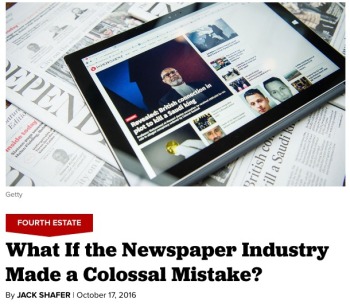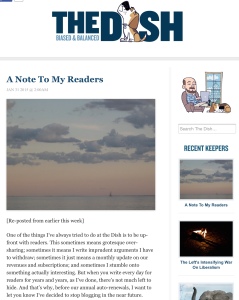The worst part about bad “newspapers made this huge mistake” stories is they spend the next week clogging my FB feed. Ugh.
— Chris Krewson (@ckrewson) October 18, 2016
 I hesitate to give more attention to a study and Politico Magazine column that comforted newspaper nostalgists, but I must: Both are BS.
I hesitate to give more attention to a study and Politico Magazine column that comforted newspaper nostalgists, but I must: Both are BS.
“What If the Newspaper Industry Made a Colossal Mistake?” asks the Politico headline, echoed in Jack Shafer‘s breathless lead: “What if almost the entire newspaper industry got it wrong?”
Well, the industry did get it wrong and did make a colossal mistake, but not the one that Shafer and University of Texas scholars Hsiang Iris Chyi and Ori Tenenboim think it made.
Summarizing Chyi’s and Tenenboim’s Reality Check research article in Journalism Practice, Shafer asks:
What if, in the mad dash two decades ago to repurpose and extend editorial content onto the Web, editors and publishers made a colossal business blunder that wasted hundreds of millions of dollars? What if the industry should have stuck with its strengths—the print editions where the vast majority of their readers still reside and where the overwhelming majority of advertising and subscription revenue come from—instead of chasing the online chimera?
In their research, which prompted Shafer’s column, Chyi and Tenenboim wrote that in the past 20 years “US newspapers, especially national and metro dailies, became more determined than ever to complete their transition from print to online. … ‘Digital first’ has become a mantra, a trend, and a strategy leading to the future.”
Shafer, Chyi and Tenenboim correctly chronicle the weak performance of American metro newspapers in the digital marketplace. But they wrongly conclude, as Shafer wrote, that “The key to the newspaper future might reside in its past and not in smartphones, iPads and VR. ‘Digital first,’ the authors claim, has been a losing proposition for most newspapers.”
Well, I used to work for a company called Digital First Media and at a newspaper-industry think tank, and I’ve visited more than 100 newsrooms and spoken at more than 100 newspaper-industry conferences and seminars, and I can flatly say that the industry never, ever adopted anything close to a digital-first strategy. (Update: Kurt Greenbaum responded on Facebook: “You’re being too kind. Not only did they never adopt such a strategy, they actively resisted tolerance of digital technology, much less acceptance of it.”)
The colossal mistake that the newspaper industry made was responding to digital challenges and opportunities with defensive measures intended to protect newspapers, and timid experiments with posting print-first content online, rather than truly exploring and pursuing digital possibilities.






